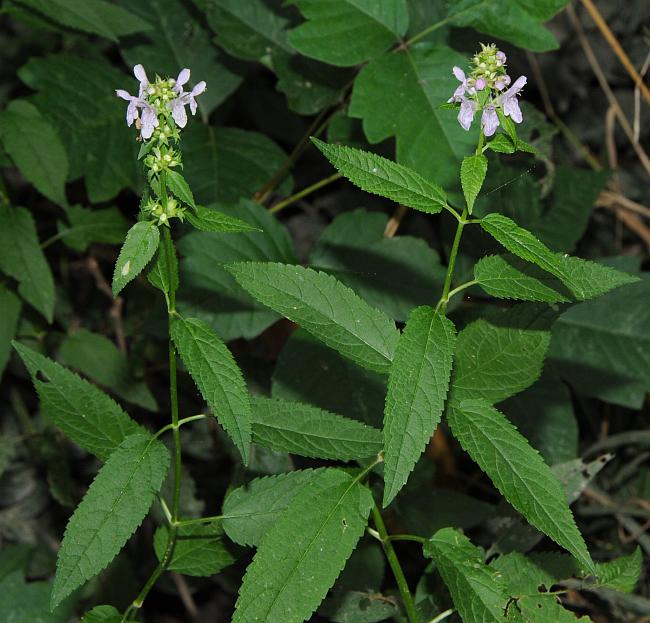Stachys tenuifolia Willd.
Thinleaf Betony

Native
CC = 4
CW = -3
MOC = 74
© SRTurner
Stachys tenuifolia Willd.Thinleaf Betony | |
 |
Native CC = 4 CW = -3 MOC = 74 |
© SRTurner |
|
Family - Lamiaceae Habit - Rhizomatous perennial forb. Stems - Ascending to erect, to 1.0 m, 4-angled, branching above, glabrous or the angles sparsely pubescent with short, downward-angled, sometimes pustular-based hairs, often with a transverse line of longer, spreading hairs at the nodes.
Leaves - Opposite, simple, petiolate. Petioles 5-35 mm long, those of the largest leaves more than 8 mm long. Leaf blades 2-12 cm long, lanceolate to oblong to ovate, angled or rounded at the base, mostly tapered to a sharply pointed tip, the margins with fine, sharp teeth, the surfaces glabrous or inconspicuously and sparsely pubescent with short, fine hairs and inconspicuous, sessile glands.
Inflorescence - Terminal spikes composed of distinct clusters, these widely or relatively densely spaced along the axis, but noticeably discrete and with the flowers not overlapping those of adjacent nodes, or less commonly dense, more or less continuous, the flowers in small clusters of 4 or 6 per node (flowers 2 or 3 in the axil of each bract), the clusters not headlike. Bracts similar to the foliage leaves but much smaller. Flowers sessile to subsessile.
Flowers - Calyces 4-7 mm long, the tube glabrous or with sparse, fine, spreading, often gland-tipped hairs, the lobes 1.5-3.5 mm long, glabrous or sparsely hairy along the margins. Corolla bilabiate, pinkish with purple streaks and spots internally. Corollas 10-13 mm long, the tube glabrous, white near base. Upper lip of corolla 5 mm long, 4 mm broad, glandular-pubescent externally, glabrous internally, obtuse at apex. Lower corolla lip 3-lobed, glabrous internally and externally. Lateral lobes 2 mm long. Central lobe 3 mm long, 3.5 mm broad. Stamens 4, didynamous, adnate at apex of corolla tube, exserted from upper lip of corolla. Filaments to 3 mm long, glandular pubescent, white. Anthers brownish-purple, 1.2 mm long. Style white to purple at apex, 1.1 cm long, glabrous. Stigma 2-lobed.
Fruits - Nutlets greenish-white, 3-ribbed, becoming black and 1.7 mm long in fruit. Flowering - June - September. Habitat - Bottomland and mesic forests, swamps, streambanks, bases of bluffs, pond margins, bottomland prairies, moist swales in upland prairies and sand prairies, marshes, fens, ditches, roadsides, moist disturbed areas. Origin - Native to the U.S. Lookalikes - Other species of Stachys, also Teucrium canadense. Other info. - This species is found across most of Missouri and most of the eastern half of the U.S. and Canada. It is recognized as a Stachys by its opposite leaves and somewhat interrupted spikes of mint-pattern flowers. Characters which point to Stachys tenuifolia include glabrous stems and calyces. However, the taxonomy of the Stachys genus is problematic, with many Missouri specimens keying poorly. More work is needed on this group. Differentiation from Teucrium is easy, as flowers of that species lack the upper lip which is present in Stachys. Stachys tenuifolia and the similar S. palustris L. would make excellent garden subjects for anyone with a shade garden and moist to wet ground. The flowers are good for attracting flying insects and are striking to look at. Photographs taken in the Irish Wilderness, Mark Twain National Forest, Oregon County, MO., 7-15-00 (DETenaglia); also along the Katy Trail near Dutzow, Warren County, MO, 8-1-2012, Lower Meramec Park, St. Louis County, MO, 8-18-2013, Tyson County Park, St. Louis County, MO, 7-27-2015, and Dresser Island Conservation Area, St. Charles County, MO, 7-28-2020 (SRTurner). |